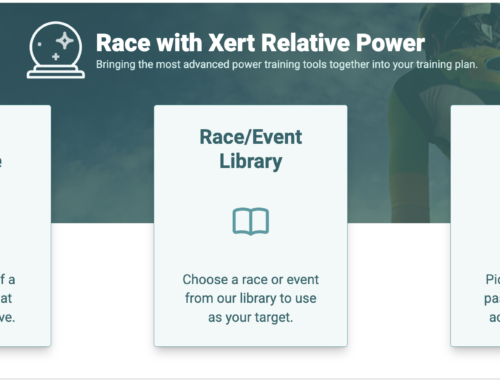An important part of all Training Programs is the need to incorporate day-to-day readiness into the program to guide what type of training should be performed on that day. In Xert, we look to model that readiness using your Training Status which uses your historical power data to estimate what level of freshness you’ll have on that day. But with other stressors playing a role in your readiness – work stress, sleep, alcohol – changes in your training may be needed in order to avoid problems such as missing workouts or even overtraining.
In this blog post, we get into more detail on how to assess your readiness to train and how to incorporate this into your training program.
Traditional Training Plans versus Adaptive Training Advisor
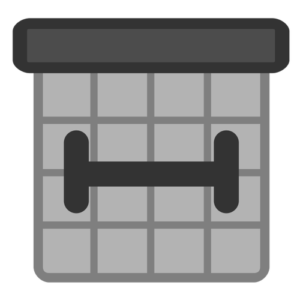
Traditionally, cyclists have prepared for the physiological demands of their events through predefined training plans. Athletes would work with a coach directly, or purchase a training program from a coach that they would follow over the next several weeks (or months). These training plans are carefully designed and work well when athletes stick to plan. However, they generally lack flexibility to adapt when life interrupts – vacations, sicknesses, or simply other life stressors. A good coach would continue to meet with their athlete and adapt the training plan, not every athlete has the luxury of working 1 on 1 with a coach.
In 2018, Xert took a radical approach to training plans with the creation of the Xert Adaptive Training Advisor, which recommends workouts on a day-to-day basis. This offers several advantages over a traditional training plan, most notably the ability to adjust each day’s training based on your personal training goals, as well as your readiness to train each day in particular. In this blog post, we will talk about different tools & methods that you can utilize to assess your readiness to train, and how that information can be used to enhance your training with Xert!
Subjective Feelings
Perhaps the most important and simplest method of assessing your readiness is by asking yourself “how do I feel today?”, or “Do I feel ready to train hard today?” This simple line of questioning is important to consider in addition to Xert’s calculated training status or any of the other readiness metrics that we will be discussed below.
Keep in mind that regardless of how you feel or what training you have recently completed, Xert will always display recommended workouts. These recommendations are always just that – a recommendation. If you are feeling too fatigued from a long/hard weekend of riding, then taking a rest day is certainly okay! On the other hand, if you’re feeling fresher than Xert indicates, you have the ability to filter or override the recommendations and select a longer or harder workout. Following the Xert Adaptive Training Advisor you can catch up on missed or modified workouts or take advantage of available training time easily. This is what makes training with a program and not a plan so advantageous.
Resting Heart Rate
Another rough estimate of daily readiness to train is your resting heart rate. There are plenty of 24/7 heart rate tracking devices which can calculate RHR (Apple, Fitbit, Garmin, etc.) or you can even just take your own pulse in the morning when you wake up. As your fitness level increases (or as you accumulate more stars in your Xert profile), you may see a reduction in your Resting Heart Rate (RHR). On the other hand, an elevated heart rate (anywhere between 2-10 bpm higher than usual) often indicates a state of stress and lower readiness for high intensity exercise. Indeed, a chronic higher resting heart rate can be a sign of overtraining or the result of illness.
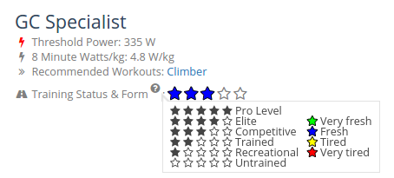
Xert’s Training Status
At a basic level, Xert helps athletes understand their readiness to train via their training status. Xert calculates your training status each day by looking at the strain (XSS) placed on each of your energy systems: low energy (associated with Threshold Power), high energy system (associated with HIE), and peak energy (associated with Peak Power). From there, Xert compares the recent strain on each system against its respective training load, which guides Xert’s training recommendations via your training status. We’ll briefly outline the various training statuses below.
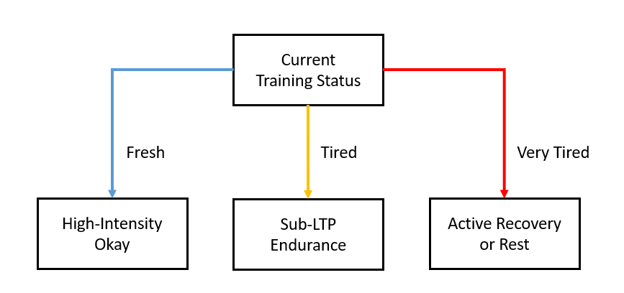
If all of your energy systems are ready to train, Xert assigns a ‘Fresh’ training status (blue/green stars). Since your high-intensity systems are ready to go, Xert will recommend high-intensity training. The Focus of the recommended high intensity training will depend on your selected Athlete Type as well as your Program Type.
If your high-intensity systems are too tired to train, but your low intensity system is still fresh, Xert assigns a ‘Tired’ training status (yellow stars) and endurance training will be recommended, or you can choose to free-ride and aim to limit the intensity below Lower Threshold Power (LTP).
Lastly, if your high-intensity systems and low intensity systems are too tired to train, Xert assigns a ‘Very Tired’ status (red stars), where active recovery workouts are recommended. When your training status is ‘very tired’, you may even consider taking a day off of training.
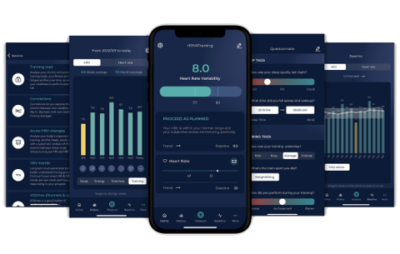
Heart Rate Variability
Our hearts do not beat perfectly like a metronome. Rather, each heartbeat is either slightly faster or slower than the preceding beat. These differences between successive beats are known as Heart Rate Variability (HRV). HRV is controlled by the body’s autonomic nervous system (ANS), which is further subdivided by the sympathetic and parasympathetic nervous system. These two systems control your ‘fight or flight’ response, as well as ‘rest and digest’.
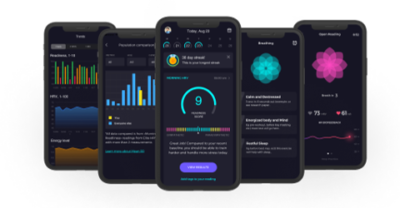 Most often these two systems are balanced, but HRV can be used to determine when there are imbalances. If the body is in a fight or flight response, the variation between successive beats typically decreases, resulting in a lower HRV. And when the body is in an overly relaxed state, the variation between successive beats is larger (higher HRV).
Most often these two systems are balanced, but HRV can be used to determine when there are imbalances. If the body is in a fight or flight response, the variation between successive beats typically decreases, resulting in a lower HRV. And when the body is in an overly relaxed state, the variation between successive beats is larger (higher HRV).
Fortunately, there are several apps, such as HRV4Training and Elite HRV, that have been developed to measure and interpret your HRV, presenting it as a daily readiness score. These apps can be used to help fine tune your training recommendations from Xert by considering additional non-training stress.
Recovery Products
Some health wearables have taken physiological monitoring a step farther by performing continuous monitoring. These products track sleep quality, respiratory rate, and HRV around the clock in an attempt to better quantify your stress and recovery. The largest players in this area are the Whoop armband and Oura ring. Similar to a daily HRV reading, these wearable products can provide a readiness score which you can use to fine tune the XATA workout recommendations. This will be discussed at the end of the blog post.
Other Stressors
However, as you might have guessed, there are other non-training stressors that can impact your readiness to train. This could include workplace or lifestyle stress, traveling, alcohol, and more. Excess alcohol consumption is known to increase RHR and decrease HRV, typically indicators of decreased readiness to train. Similarly, long days of traveling (driving, flying, etc.) also negatively impact readiness to train. These stressors should also be considered when determining your readiness to train.
Overreaching vs. Overtraining
So why is the concept of daily readiness important? Building fitness is based upon the principle of Progressive Overload – in order to gain fitness, you need to push your body beyond what it is used to. This principle is universal across different sports, from 100m sprinters to power-lifting athletes to amateur cyclists. The idea is that after training, your body is temporarily weaker than before training – this is a direct result of applying strain (XSS) to your various energy systems. With sufficient recovery between training sessions, your body will adapt and strengthen.
However, more is not always better. If you continue to push yourself hard without sufficient recovery, especially when you’re feeling tired, you risk reaching a point of non-functional overreaching – more commonly referred to as overtraining. Overtraining is associated with a myriad of symptoms ranging from mood swings, to general fatigue, and poor quality of sleep. You might see signs of overreaching if your training status is consistently red, i.e. very tired, for many days or consistently yellow, i.e. tired, weeks on end.
It’s worth pointing out that you can – and should – still train when you are not feeling 100% fresh. In fact, Xert’s Adaptive Training Advisor was built upon this principle! However, it’s important to point out that you must avoid riding hard when your training status is Tired, or if you are feeling tired. In these situations, you can continue functional overreaching by riding at an endurance pace – limit the intensity to no more then your Lower Threshold Power. By riding easy, you can still progressively overload your low energy system (Threshold Power) while also allowing your high intensity systems (High Intensity & Peak Intensity) to recover.
Incorporating Daily Readiness with Xert Adaptive Training Advisor
Now that we’ve discussed various tools that are available to you, how can you use these tools in combination with Xert? We’ll discuss some general rules of thumb below. These rules can be summarized using the flowchart below:

Start by looking at your training status in Xert. Are you considered fresh, tired, or very tired? Secondly, what is your subjective feeling? Does your gut feeling align with Xert’s calculated training status? Also consider your physiological measures – how is your resting heart rate, daily HRV, and/or readiness score? This is where you can truly start to take even more control over your training with Xert!
The next step is to use that physiological feedback to fine tune Xert’s recommendations
- If you’re feeling more fresh than Xert indicates, move the Freshness Feedback slider to the right. This will let Xert know that you can train more and/or harder.
- If you’re feeling more tired than Xert indicates, move the Freshness Feedback slider to the left. This will let Xert know that you need to train less or easier. Alternatively, you can consider taking a rest day if needed.
Wrap Up
One of Xert’s most powerful features is the ability to adapt your training program on a day-by-day basis. In today’s blog post, we discussed a variety of methods & tools that you can utilize in addition to the Xert Adaptive Training Advisor and the Freshness Feedback Slider to take even greater control of your training.


